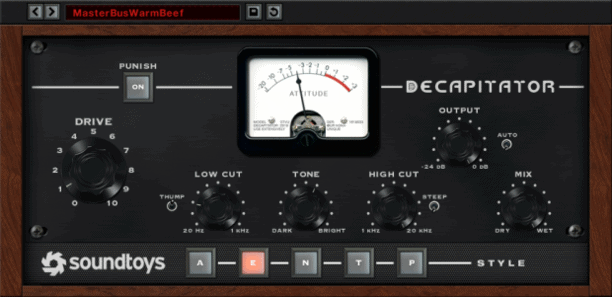Working with audio ‘in the box’ provides little room for pushing past the boundaries of your device. Once you reach the upper limit of your digital gear, there’s no going any further. However, when you overdrive analog gear, the result can be very different – tube saturation, pleasing even-order harmonics, warmth and character. SoundToys aims to bring a little bit of analog gear saturation to the digital realm with Decapitator ($179.99 Native).
The folks at SoundToys chose five pieces of classic analog recording gear, and modeled how they reacted as they were pushed to the point of saturation and then well beyond their normal limits. This resulted in five unique saturation algorithms, which are represented on the decapitator by the ‘Style’ buttons (labeled A, E, N, T, P). These choices include an Ampex 350 tape drive preamp, a Chandler/EMI TG channel strip, a Neve 1057 input channel, and a Culture Vulture distortion device (with either the triode or pentode tube setting).
The Drive control will increase the amount of gain and distortion of your signal, ranging from subtle to over-the-top. While there is also an Output control, turning on the Auto Output switch will decrease the output level as you increase the drive – making it easy to add distortion without any extra gain. Additionally, the aptly named Punish button adds an extra 20dB of gain if you happen to max out the drive control and really want to push the distortion.
The Low Cut, Thump, and Tone controls all affect the signal before it’s affected by the saturation algorithm, allowing you to tweak which frequencies get distorted. The Low Cut is variable from 20Hz to 1kHz, and is useful for removing enough lows to prevent the signal from sounding tubby after distortion. For the opposite effect, hit the Thump switch, which will cause a boost at the Low Cut frequency, lending some thickness that is similar to tape saturation. The Tone knob is a gentle equalizer that will boost the highs while attenuating the lows, or vice-versa.
After the signal has been processed, the High Cut control makes it easy to remove some of the high end fizz and harshness from your distortion, while the Steep switch changes the high rolloff from 6dB to 30dB per octave. Especially handy with this plugin is the inclusion of a Mix control. The ability to balance between the wet and dry signals lets you preserve the clarity and transients of the original signal, while blending in the grit, warmth and character provided by Decapitator.
This plugin is easy to use, and much more versatile than it seems. As opposed to simple tape saturation or distortion plugins, Decapitator recreates the effect of overdriving high quality studio equipment – the way engineers push mic preamps past their limits, or use ‘all button mode’ on an 1176. Depending on the settings, it can add some grit and warmth to overly clean synth tracks, or cook a snare track until it’s extra crispy. I loved it on bass, using a moderate amount of drive and the Culture Vulture Pentode setting added some fatness and crunch. The Ampex saturation algorithm was great for vocals both subtly and in combination with some extreme high and low cut settings as an effect. Actually, Decapitator sounded pretty damn cool on everything I tried it on. That, in combination with a useful auto output switch, wet/dry control, and five different saturation algorithms make this plugin a real stand-out when it comes to adding some mojo to your tracks. Check out some of SoundToys’ other plugins here.
–Mike Bauer























